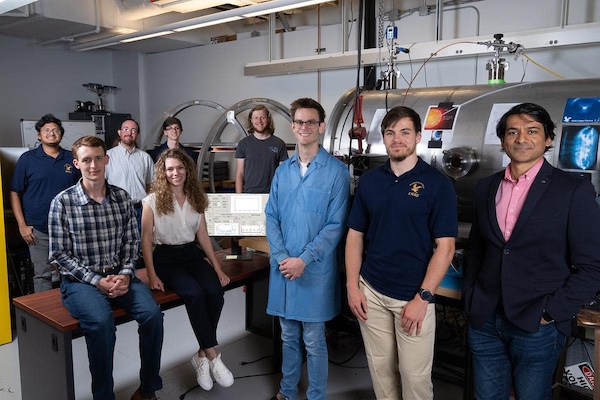Indian American Scientist Aroh Barjatya Headed NASA Mission During Solar Eclipse to Study Effects On Earth’s Ionosphere
- A professor of engineering physics at Embry-Riddle Aeronautical University in Florida, he oversaw the launch of three sounding rockets from Virginia.

Indian American scientist Aroh Barjatiya headed a National Aeronautics and Space Administration (NASA) mission during the solar eclipse today. The space agency launched three sounding rockets to study the effects on the Ionosphere, Earth’s upper atmosphere.
Barjatya is a professor of engineering physics at Embry-Riddle Aeronautical University (EMRU) in Florida, where he directs the Space and Atmospheric Instrumentation Lab. His research interests and active projects span small satellites, sounding rockets, high-altitude balloons, spacecraft charging, embedded electronics, space situational awareness, and space systems engineering. He is currently part of six additional missions, including a NASA mission to Mars.

“Understanding how an eclipse sets off a unique pattern of atmospheric waves in the ionosphere is a key goal for Barjatya and colleagues,” according to a University of Florida press release. His team included professor of Engineering Physics Dr. Matthew Zettergren; research scientists Dr. Robert Clayton and Dr. Shantanab Debchoudhury; Ph.D. students Rachel Conway, Henry Valentine and Nathan Graves; master’s degree students Peter Ribbens, Joshua Milford and Jonas Rowan; and undergraduate students Megan Soll, Johnathan Bizzano and Maddox Morrison.
Each solid, two-stage rocket, spanning about 53 feet from tail to tip, zoomed over Route 70 and soared up to 350 kilometers into the ionosphere, NASA said. “Each rocket’s main payload will also dispatch four sub-payloads of highly sensitive scientific instruments into space,” the agency added.
The instruments for the sounding rocket mission were built by researchers at Embry‑Riddle and Dartmouth College. Barjatya told EMRU News that the name APEP, for Atmospheric Perturbations around the Eclipse Path, was ‘inspired by a giant mythological snake called Apep that chased the sun god Ra in ancient Egyptian lore — an event deemed responsible for causing eclipses.’
He said the rockets were “refurbished and capable of deploying several smaller rockets to help measure the eclipse’s impact on the ionosphere,” according to a NASA press release. “Each rocket will eject four secondary instruments the size of a two-liter soda bottle that also measure the same data points, so it’s similar to results from fifteen rockets, while only launching three,” he explained.
The first Atmospheric Perturbations around Eclipse Path (APEP) sounding rocket took off from NASA’s Wallops Flight Facility in Virginia at 2:40 p.m., about 45 minutes before the eclipse, NASA said. The second was launched at around 3:25 p.m. “during the peak of the eclipse, with the third delayed for a few minutes before taking off at 4:28 p.m,” the New York Post reported.
NASA noted that the sounding rockets had been “previously launched and successfully recovered from White Sands Test Facility in New Mexico, during the October 2023 annular solar eclipse.” Since then they have been “refurbished with new instrumentation,” the agency added.
A space systems expert, Barjatya has written or co-written11 successful proposals over the last decade to various federal funding agencies that resulted in over $74 million of funding for delivering hardware to be launched in sounding rockets, CubeSats/SmallSats, and high-altitude balloons. He has overseen seven space flight projects from the proposal stage to requirements review, PDR, CDR, MRR, launch and commissioning.
As a tenured full professor and program coordinator for the Engineering Physics program at ERAU, he led and developed a five-year strategic plan for the department, started the Spacecraft Instrumentation area of concentration within the major, and performed an annual assessment of the program, including a five-year comprehensive review that provided a metrics-based assessment of our progress.
He is an active member in multiple cross-disciplinary academic societies such as AGU, Senior Member in IEEE, AIAA, etc. He has also organized sessions and panels at multiple conferences and workshops. He currently serves on the NASA Heliophysics Advisory Committee and NASA Space Environment Technical Definition Team, and a past member of NASA Sounding Rocket Working Group. He holds a Ph.D. in Electrical Engineering: Atmospheric and Space Sciences, from Utah State University, and an M.S. in Electrical Engineering from Utah State University.
Hundreds of thousands of people witnessed today’s solar eclipse as the moon moved between the Earth and the sun, blocking the star’s light. From Texas to Maine and beyond, people wore their eclipse glasses and watched the celestial spectacle amid loud cheers and applause. , passing over Mexico, across the United States from Texas to Maine, and continuing over Canada’s Atlantic coast.
For scientists, it was an opportunity to gather invaluable data on everything from the Sun’s atmosphere to strange animal behaviors — and even possible effects on humans.


